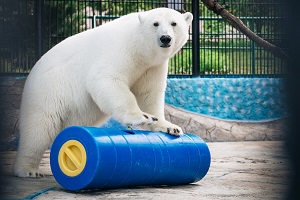
Rosneft specialists, together with the Conservation Society and the Wildlife Research, for the first time in Russia have developed special toys for polar bears under the Company’s care in all zoos of the country. In order to diversify the habitats of Arctic predators in their zoo houses, 64 toys were made of especially strong plastic of two kinds: collapsible “ball” and “cylinder”. The cost of the samples was three times lower than that of their foreign counterparts and of comparable quality.
 Refinement of zoo houses with various objects used by polar bears for games is a prerequisite for their maintenance in artificial conditions. Their constant physical activity helps reduce the development of stereotypical behaviour.
Refinement of zoo houses with various objects used by polar bears for games is a prerequisite for their maintenance in artificial conditions. Their constant physical activity helps reduce the development of stereotypical behaviour.
When developing the toys, Rosneft specialists together with the Conservation Society and the Wildlife Research analysed the habitats of polar bears in zoos and carried out research and development and design work.
 All the toys are made of environmentally friendly materials and are absolutely safe for the animals. The design features of the toys ensure their durability, resistance to mechanical influences, UV radiation, and temperature fluctuations. In addition, a special methodological guide to refining the habitat of polar bears in zoos is currently being composed.
All the toys are made of environmentally friendly materials and are absolutely safe for the animals. The design features of the toys ensure their durability, resistance to mechanical influences, UV radiation, and temperature fluctuations. In addition, a special methodological guide to refining the habitat of polar bears in zoos is currently being composed.
The first batch of the toys will be delivered to Russian zoos by the end of July, including the Krasnoyarsk park of flora and fauna “Royev Ruchey”, where the bears rescued by Rosneft from Norilsk and Dixon are kept.
 |
 |
Note for Editors:
Since 2013, polar bears of all Russian zoos have been under the treatment of the Company. By now, Rosneft provides management (nutritional wellbeing, veterinary attendance, and the habitat refinement) of 35 polar bears in 16 Russian zoos. Also, Rosneft has been implementing an integrated programme on the support and protection of polar bears that include rescuing and recovery management of young orphaned bears. The programme covers care for the animals in all zoos of Russia.
Rosneft pays special attention to the conservation and research of the polar bear. During its complex Arctic expeditions, Rosneft is carrying out research of polar bears, using advanced technology. Animals are marked with special collars fitted with satellite transmitters to track their routes; biological samples are being taken. The results of immunologic, microbiologic, and molecular-genetic research of all the biological probes taken allow evaluating of grade and contents of anthropogenic substances in the polar bear organism, assessing of health state of different age-sex groups in varying habitats, and defining of the degree of studied individuals relationship.
According to the specialists’ research, there are from 22,000 to 31,000 polar bears across the globe nowadays. Polar bears inhabit all Arctic Basin including its shores and islands. There are no geographical boundaries for the species. The main factors determining its spreading are the marine ice, the existence of places suitable for birth lair making, and the food accessibility.
Rosneft
Information
Division
July 18, 2019
